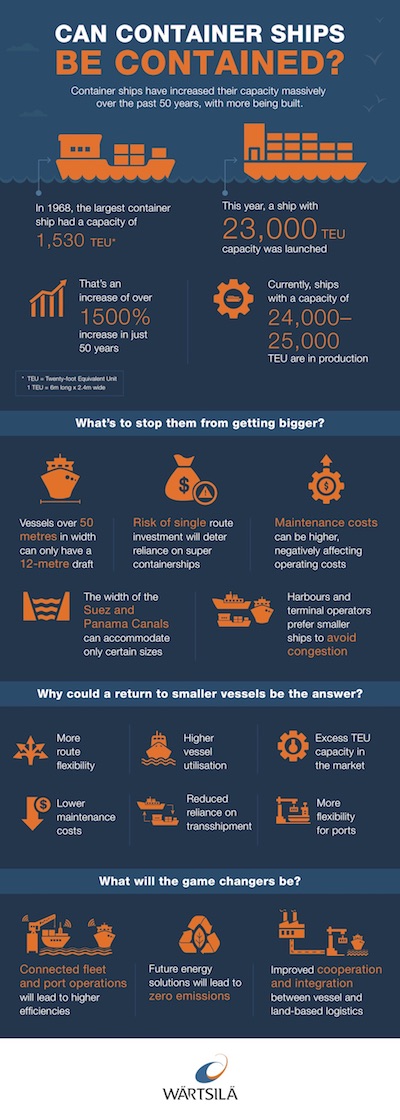

Container ships have increased in size every year since the advent of containerised shipping itself. Will this trend continue in the future?
Ever since the advent of containerised shipping in the 1960s, container ships have grown steadily larger. According to Allianz Global Corporate and Specialty (AGCS), by 2017, container-carrying capacity had increased by almost 1,500% from 1968. In 2017, the largest ships were around 21,400 TEU. Today, just two years later, ships ranging from 24,000-25,000 TEU are being ordered and built.
Will there eventually come a point at which container ships are too large? Or is bigger always better?
Lars Jensen, CEO of SeaIntelligence Consulting, says there are a number of economic reasons the ideal size of container ships will eventually hit an upper limit.
“At an individual vessel size, larger vessels make sense. Sure, the overall cost of the vessel gets a bit more expensive, but fuel costs don’t go up much, so the cost per unit is lower. But from a global network perspective, it no longer makes sense,” Jensen says.
He notes that after a certain point, filling the cargo for larger ships becomes a struggle. Shipping lines have to form alliances, which restricts the supply chain in direct opposition to contemporary demand trends.
“The ultra-large vessels are dependent on the assumption that manufacturing takes place in a few concentrated areas and only a few places are foci of demand; however, this isn’t the case: demand is becoming more dispersed. You’re also
seeing more desire to see goods delivered directly to smaller cities,” Jensen says.
Logistical limitations
The logistics of global shipping routes also are a natural limitation to ship size.
“The Suez Canal is a limiting factor, as a connection between Asia and Europe. It’s a bottleneck in the overall path, and ships have to go through it,” says Matthias Becker, Managing Director, Wärtsilä Germany. “If ships are going beyond 50 metres width, they’re only allowed to have 12 metres draft, so 24,000 TEU ships are approaching this limit.”
Becker adds that container stack weight is another limiting factor for container ship size. Shipowners are already stacking containers to the maximum of nine high.“
We’re already at the physical limit of what containers can withstand in terms of stacking,” Becker says, limiting opportunities to expand capacity through vertical growth.
Additionally, existing port and logistics infrastructure poses a challenge to larger ships.
“In the U.S., ships have already been restricted to a certain size (18,000 TEU in some U.S. harbours), and many European harbours are also saying that there should be a limit to container ship size,” Becker says. “For terminal operators and those who have to pay for the infrastructure, they want to limit ship sizes because the hinterland and harbour infrastructure can’t stand the biggest ships. Once a big ship is in, there’s congestion due to trucks waiting for the unloading.”
A return to smaller ships?
Jensen thinks that eventually there will be a trend to return to smaller ships.
“The 14,000-15,000 TEU ships have the advantage of more frequent weekly service, reduced reliance on trans-shipments and more flexibility of ports. Looking at very round numbers for a carrier’s operational costs, the amount of money they spend on fuel is roughly equal to the amount they spend on port and terminal operations. If they’re able to reduce reliance on trans-shipment, they can cut that cost 100% for the affected trans-shipped containers which is an immediate cost payback,” Jensen says.
Becker, on the other hand, believes that the pure cost of transport will continue pushing shipowners towards 24,000 TEU-range ships. He argues that the economic gain from reduced cost per unit and greater operational efficiency is too compelling for shippers to downsize.
“As long as ships are able to navigate the existing supply routes and
operational costs are reduced by bigger ships, there’s no reason to return to smaller ships,” Becker says.
Options for improving efficiency
Due to the maturity of container ship technology, Becker expects few technological efficiency gains onboard container ships. However, he notes that there are areas that can be improved across the supply chain.
“Connecting the ship to the shore in order to keep everyone informed about a ship’s precise arrival time and using that information to coordinate logistics would improve overall efficiency and reduce costs,” Becker says.
Over the long term, Becker expects ships’ environmental impact to decrease through the adoption of natural gas, then synthetic natural gas, instead of oil.
“Container ships are relatively fast, so they’re burning tons of fuel. The focus for development is on what kinds of fuel and how to improve the vessel’s environmental footprint without compromising efficiency,” Becker says.
Ultimately, Becker predicts the thinking about container ships will shift from seeing them as isolated units to considering them as part of a larger ecosystem that includes the port.
“Rather than being determined only by what shipyards can design and build, future container ships’ sizes will be determined
by a consideration of both ships’ and land-based logistics’ optimisation,” Becker says.


